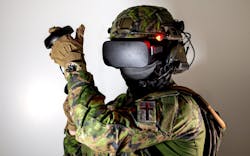Demand for military 5G to quadruple over next five years, driven by autonomous vehicles, communications
NORTHBROOK, Ill. – Demand for military 5G communications networking and equipment will nearly quadruple over the next five years, driven by the growing adoption of connected and autonomous devices, according to analysts at market research MarketsandMarkets Inc. in Northbrook, Ill.
The 5G defense market will grow from $665 million this year to $2.5 billion in 2027, which represents a combined annual growth rate of 30.2 percent, analysts say.
MarketsandMarkets unveiled this military 5G market analysis in the report titled 5G in Defense Market by Communication Infrastructure (Small Cell, Macro Cell), Core Network Technology, Platform (Land, Naval, Airborne), End User, Network Type, Chipset, Operational Frequency, Installation and Region - Global Forecast to 2027.
Factors such as the need for higher network speed, lower latency in 5G, and the growing adoption of autonomous and connected devices are driving factors in 5G defense market growth, analysts say.
Related: What 5G means to the military
The 5G defense market includes major players Ericsson in Sweden; Huawei in China; Nokia OYJ in Finland; Samsung in South Korea; NEC Corp. in Japan; Thales Group in France; and U.S. companies L3Harris Technologies Inc., Raytheon Technologies, Ligado Networks, and Wind River Systems Inc.
By communications infrastructure, the small cell segment is expected to dominate 5G in the defense market during the forecast period. Small cell segment growth comes from the large-scale deployment of small cells by 5G network operators.
With the further introduction of the 5G network, the data connectivity speed is expected to increase significantly. As small cells can help facilitate 5G deployment, they are expected to play a pivotal role in the market for 5G communication infrastructure.
Related: Wanted: spectrum management for 5G tactical networking
By platform, aircraft will lead 5G in the defense market during the forecast period. Airborne applications like uncrewed aerial vehicles (UAVs) and mission-critical communications should be able to perform with increased efficiency.
North America is expected to lead the 5G in the defense market during the forecast period in applications such as intelligence, surveillance & reconnaissance) systems; command and control. The allocation of a wide frequency band to the U.S. military has opened new opportunities for system designers to develop 5G enabled components.
For more information contact MarketsandMarkets online at www.marketsandmarkets.com/ResearchInsight/5g-defense-market.asp.

